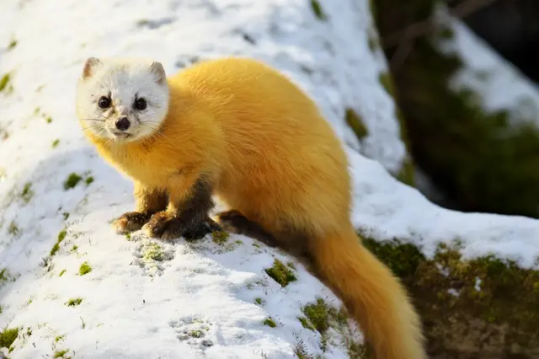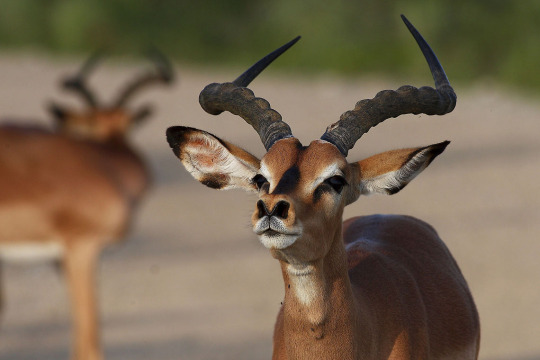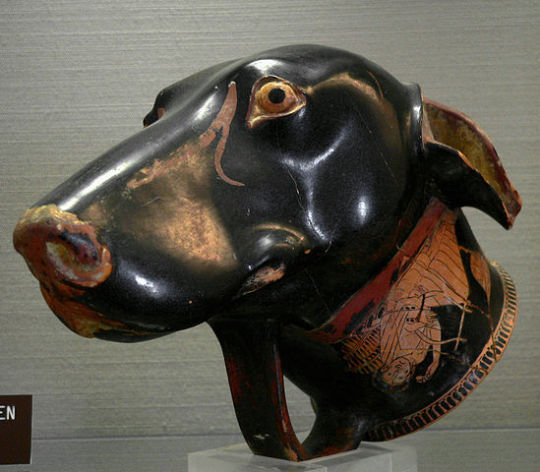#Melampus
Text
La vecchiaia è una realtà che deve esserti comunicata, da solo non si riesce mai a intenderla, può essere scambiata per stanchezza, per noia, e anche per un raffinamento del gusto, del modo di intendere la vita: chiudersi, star soli, leggere e rileggere, sentirsi saggi.
Ennio Flaiano, "Melampus, La metamorfosi amorosa di una donna", 1970, cap. 12
79 notes
·
View notes
Text

Common impala Aepyceros melampus
With red-billed oxpecker Buphagus erythrorhynchus
Observed by lemoncul, CC BY-NC
#Aepyceros melampus#common impala#Bovidae#antelope#non-ungulate#bird#passerine#Buphagus erythrorhynchus#red-billed oxpecker#Africa#Malawi
33 notes
·
View notes
Text

HMS Melampus, 36- guns, 1785 (detail), by Chris Woodhouse, 1990
109 notes
·
View notes
Text

The Pallah | African scenery and animals (1804) | Samuel Daniell | Flickr
#samuel daniell#vintage art#aquatint#animal art#animal#bovidae#antelope#rooibok#impala#common impala#aepyceros melampus
3 notes
·
View notes
Text

Common Impala | Judd Patterson
#photo#bovidae#antilopinae#aepyceros#aepyceros melampus#aepyceros melampus melampus#impala#common impala
1 note
·
View note
Text

Impala in Akagera National Park, Kayonza, Rwanda
Max Christian
Speed: 47 – 56 mph (Running, In a zig-zag)
Mass: 88 – 170 lbs (Male, Adult), 66 – 110 lbs (Female, Adult)
Animal sounds: an explosive 'chuff' alarm bark – wildambience.com
Gestation period: 183 – 213 days
Scientific name: Aepyceros melampus
Trophic level: Herbivorous
The impala or rooibok is a medium-sized antelope found in eastern and southern Africa. The only extant member of the genus Aepyceros, and tribe Aepycerotini, it was first described to Europeans by German zoologist Hinrich Lichtenstein in 1812.
The impala inhabits woodlands due to its preference for shade; it can also be found on the interface (ecotone) between woodlands and savannahs. Places near water sources are preferred. In southern Africa, populations tend to be associated with Colophospermum mopane and Acacia woodlands.
Impalas are herbivores (folivores). As grazers, these antelopes consume grass, while as browsers, they feed upon wide variety of vegetation, including fruits, seedpods, shoots as well as leaves of trees and bushes.
Most impalas are currently not endangered, about two million impala live in the wild or on private land today. About one quarter of these live in protected areas in Botswana, Kenya, South Africa, Tanzania, Zambia, and Zimbabwe.Oct 21, 2023
#Akagera National Park#Kayonza#Rwanda#Africa#Wildlife#RwandaWildlife#Impala#Antelope#Aepyceros melampus
1 note
·
View note
Text
Phylogenetic weasel tournament
Family: Mustelidae
Subfamily: Guloninae
Genus: Martes


Another incredible mustelid enters the tournament. This family just gives and gives




pictures: 1, 2, 3, 4, 5, 6
#yellooowww#polls#tournament poll#phylogenetic weasel tournament#guloninae#pacific marten#japanese marten#nyugati és feketelábú nyest magyarul#nem hiszem el hogy valaki a fekete lábat látta a legjellegzetesebbnek rajta
69 notes
·
View notes
Text


Japanese marten (Martes melampus)
Tokyo, Japan
Photos © Nature Production
284 notes
·
View notes
Text

Impala (Aepyceros melampus)
Also known as the roibok, these lithe antelope are found in woodlands and savannas across southeastern Africa. They eat a variety of vegetation, as well as fruit. Impalas have impressive leaping abilities- they can leap up to 9.8 feet (3m) into the air and across distances of 33 feet (10m). They also have a unique tooth arrangement which they use to groom each other, an important part of social bonding.
#markhors-menagerie#animal facts#animals#biology#fun facts#ungulates#even toed ungulates#ruminants#bovidae#antelope#impala#roibok
31 notes
·
View notes
Text
Animal of the Day!
Black-faced Impala (Aepyceros melampus petersi)

(Photo by Burak Dogansoysal)
Conservation Status- Vulnerable
Habitat- Southwestern Africa
Size (Weight/Length)- 76 kg; 160 cm
Diet- Leaves; Fruits; Shrubs
Cool Facts- The black-faced impala is the largest of the impala subspecies. When watching an animal documentary, you might think that impala are the joke of the African animal kingdom. Targeted by almost all predators from lions to cheetahs to crocodiles, these impala have beat the odds. Capable of leaping 3 meters directly into the air and up to 10 meters in a single stride while running, black-faced impala can run up to 90 kilometers per hour. Impala have a unique way to ward off predators if running does not work. They begin stotting. It appears as if the impala is bucking while running, and while it may be slower it also shows the impala’s strength to the predator as if saying “I’m fast and strong, don’t eat me.”
Rating- 12/10 (Can clear a one story house in one jump.)
#animal of the day#animals#mammals#antelope#thursday#june 15#black-faced impala#impala#biology#science#conservation#the more you know
141 notes
·
View notes
Text

nimbus, the white lanner
—
Nimbus’s Feather
A feather imbued with water aspected aether. Cool to the touch.
Material used for crafting items.
After many millennia, wings unfurl once more toward a familiar hue.
—
an oc lore post for Avi’li Sostomi
Long ago before the world was sundered into fourteen, an Ancient by the name of Melampus brought into creation a bird that could bring rain to the thirsty and malnourished across Ethierys (she probably did this illegally tbh; a fan of Amaurotine bureaucracy she is not, which is why there has ever only been one Nimbus)
She thought herself an ineffective teacher to the bird, so she entrusted it to a close friend, Apollo, apprentice and apparent successor to Azem, who could serve as a guide and mentor both as they travel the Star, bringing with them rain and succor
Apollo named this bird Nimbus, the Rainbringer
Nimbus and Apollo had a strong bond, not unlike Avi’li and Otes and Ardbert and Seto
After the Sundering, Nimbus kept to the aetherically dense regions of ice and water, both on the Source and Reflections, living and hunting for thousands of years…
…until, just a few years ago, Nimbus sensed a familiar presence in the Sea of Clouds
Avi’li, through the Echo, felt an immediate kinship with the beast, and recalled its given name: Nimbus
Nimbus now follows Avi’li, always close and sticking to the clouds overhead unless called upon
With its great wings, Nimbus reaches heights and speeds that would strain Otes, so Avi’li oft calls upon Nimbus to cover large distances quickly
Nimbus can also travel through aetherically dense clouds and fog to travel between the Source and Reflections, barring specific circumstances
#oc: avi’li#avi’li lore#something that just solidified in my brain inspired me to do this short write up lol#i like the idea of adding gposes to these lore posts as I get around to making them :>#endwalker spoilers#<- for specific mentions
11 notes
·
View notes
Text
A una certa età ci si accorge che un amore riassume tutto e che si amano varie ipotesi di una stessa persona o, se preferite, una stessa ipotesi di varie persone.
Ennio Flaiano, "Melampus, La metamorfosi amorosa di una donna", 1970, cap. 12
64 notes
·
View notes
Text

Common impala Aepyceros melampus
With red-billed oxpecker Buphagus erythrorhynchus
Observed by jrgale, CC BY-NC
#Aepyceros melampus#common impala#Bovidae#antelope#non-ungulate#bird#passerine#Buphagus erythrorhynchus#red-billed oxpecker#Africa#Zimbabwe
26 notes
·
View notes
Text

Some Pet Dog Names from Ancient Greece
When the hound has caught the hare, or been otherwise victorious in the course, you should […] pat him with your hand and praise him, kissing his head, and stroking his ears, and speaking to him by name […] for, like men of generous spirit, they love to be praised; and the dog, if not quite tired out [from the hunt] will come up with joy to caress you. (Arrian, On Coursing, XVIII Pg 116 trans. William Dansey)
As many dogs were hunting hounds or guard dogs in Ancient Greece, it followed that the naming convention was dependant on psychology; to name the dog something strong or skilful was to boast of the animals’ superiority to others of its breed, just as it reflected on the owner. There are some well known dogs in Ancient Greek history that many are aware of, namely Cerberus, Odysseus’ faithful dog Argos, and Alexander the Great named a city after his dog Peritas. We are lucky to have two lists of excellent dog names from authors Xenophon and Ovid.
From Xenophon (~ 430 - 355 BC), in his treaties on Hunting, we have the below list:
Give the hounds short names, so as to be able to call to them easily. The following are the right sort: Psyche, Thymus, Porpax, Styrax, Lonchê (Lance), Lochus, Phrura, Phylax (Sentinel/Guardian), Taxis, Xiphon, Phonax, Phlegon, Alcê (Stout), Teuchon, Hyleus, Medas (Crafty), Porthon, Sperchon (Bustler/Hasty), Orgê, Bremon, Hybris, Thallon (Vigorous), Rhomê, Antheus (Blossom), Hebe, Getheus, Chara (Jolly/Ecstasy), Leusson, Augo (Bright), Polys, Bia, Stichon, Spudê, Bryas, Oenas (Blueskin), Sterrus, Craugê, Caenon, Tyrbas, Sthenon, Aether, Actis, Aechmê, Noes (Counsellor), Gnomê, Stibon, Hormê (Impetus). (Xenophon Kynegetikos On Hunting 7.5)
A kind person on Reddit suggested these names could also translate as:
Psyche = Psyche / Spirit
Thymus = Pluck
Porpax = Buckler
Styrax = Spigot
Lonche = Lance
Lochus = Lurcher
Phrura = Watch
Phylax = Keeper
Taxis = Brigade
Xiphon = Fencer
Phonax = Butcher
Phlegon = Blazer
Alce = Prowess
Teuchon = Craftsman
Hyleus = Foster
Medas = Counsellor
Porthon = Spoiler
Sperchon = Hurry
Orge = Fury
Bremon = Growler
Hybris = Riot / Insolence
Thallon = Bloomer
Rhome = Rome / Mighty
Antheus = Blossom
Hebe = Hebe / Youth (Young’n)
Getheus = Hilary / Happy
Chara = Jollity
Leusson = Glazer
Augo = Eyesbright
Polys = Much
Bia = Force
Stichon = Trooper
Spude = Bustle
Bryas = Bubbler
Oenas = Rockdove
Sterrus = Stubborn
Crauge = Yelp
Caenon = Killer
Tyrbas = Strongboy / Riot
Sthenon = Sky
Aether = Sunbeam
Actis = Bodkin
Aechme = Wistful
Noes = Gnome
And from Ovid (~ 43 BC - 17 AD), in his Metamorphosis, of the dogs that attacked their master Actaeon, we have:
First ‘Black-foot’, Melampus, and keen-scented Ichnobates, ‘Tracker’, signal him with baying, Ichnobates out of Crete, Melampus, Sparta. Then others rush at him swift as the wind, ‘Greedy’, Pamphagus, Dorceus, ‘Gazelle’, Oribasos, ‘Mountaineer’, all out of Arcadia: powerful ‘Deerslayer’, Nebrophonos, savage Theron, ‘Whirlwind’, and Laelape, ‘Hunter’. Then swift-footed Pterelas, ‘Wings’, and trail-scenting Agre, ‘Chaser’, fierce Hylaeus, ‘Woody’, lately gored by a boar, the wolf-born Nape, ‘Valley’, Poemenis, the trusty ‘Shepherd’, and Harpyia, ‘Snatcher’, with her two pups. There is thin-flanked Sicyonian Ladon, ‘Catcher’, Dromas, ‘Runner’, ‘Grinder’, Canache, Sticte ‘Spot’, Tigris ‘Tigress’, Alce, ‘Strong’, and white-haired Leucon, ‘Whitey’, and black-haired Asbolus, ‘Soot’. Lacon, ‘Spartan’, follows them, a dog well known for his strength, and strong-running Aëllo, ‘Storm’. Then Thoos, ‘Swift’, and speedy Lycisce, ‘Wolf’, with her brother Cyprius ‘Cyprian’. Next ‘Grasper’, Harpalos, with a distinguishing mark of white, in the centre of his black forehead, ‘Black’, Melaneus, and Lachne, ‘Shaggy’, with hairy pelt, Labros, ‘Fury’, and Argiodus, ‘White-tooth’, born of a Cretan sire and Spartan dam, keen-voiced Hylactor, ‘Barker’ […] First ‘Black-hair’, Melanchaetes, wounds his back, then ‘Killer’, Theridamas, and Oresitrophos, the ‘Climber’, clings to his shoulder. (Ovid Metamorphoses III 206-233 trans. A S Kline)
Theoi has Brookes More’s translation which offers a few English variations on the names.
A few fun ideas to keep in mind if looking to name a new pet in Ancient Greek style.
For I have myself bred up a hound whose eyes are the greyest of grey; a swift, hard-working, courageous, sound-footed dog[…]. He is most gentle, and kindly-affectioned […] as soon as he catches sight of me, showing symptoms of joy, and again trotting on before me. […] He is the constant companion of whichever may be sick; and if he has not seen either of us for only a short time, he jumps up repeatedly by way of salutation, and barks with joy as a greeting. (Arrian, On Coursing, V Pg 78-80 trans. William Dansey)
🐶 Sources
Xenophon Kynegetikos
Arrian On Coursing
Ovid Metamorphoses III
Dog shaped Rhyton by the Brygos Painter in Aleria
81 notes
·
View notes
Text

Japanese Marten (Korean subspecies)
Martes melampus coreensis
8 notes
·
View notes
Text

Common Impala | Justyn Stahl
#photo#bovidae#antilopinae#aepyceros#aepyceros melampus#aepyceros melampus melampus#impala#common impala
0 notes